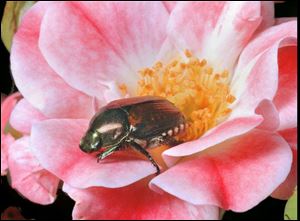
Battle beetles with a ground attack on grubs
8/3/2005This is the week to treat lawns for grubs. Many grubs grow up and become Japanese beetles. Treatment now will stop the grubs from munching on the lawn later in the season.
Mark Underwood of Underwood Nursery in Adrian says beetle season is in its final weeks.
Adult Japanese beetles are metallic green with copper-colored wing covers and usually grow about half an inch long. They start out as fat C-shaped grubs that feed on turf roots. The adults emerge in June, feed on the leaves and flowers, and mate. Then the females burrow into the soil and lay eggs.
Mr. Underwood says he sees a higher concentration of beetle damage near golf courses and farm fields, but he says their population is lower than last year. He credits the drop to aggressive grub control, adverse moisture levels, and high temperatures as the beetles emerged in June.

A Japanese beetle crawls on a small rose.
Mr. Underwood recommends treating the grubs to keep Japanese beetles at bay.
"Applying Merit before Aug. 15 will fight young grubs in their small larval stage," he says. "If you don't get it down soon, you will have to use another chemical like Dylox or Sevin in September or October."
Biological controls like bacterial milky disease will help control grubs, but it may take two to three years before the spore counts are high enough to be effective. There are also parasitic nematodes on the market like BioSafe, BioVector, Exhibit, and ScanMask that have been tested and scientists say they are marginally effective.
Japanese beetles aren't known to bite, so they can easily be plucked from plants and submerged in a jug of soapy water.
If the beetles aren't visible on leaves, make a closer inspection to make sure the plants are pest-free. "Shake or spray your bushes or trees with a hose to see if you have Japanese beetles," Mr. Underwood says. "They will fly out and you can see how big of a population you have feeding on your plants."
Roses are one of their favorite perennials.
"They will feed on many perennials and shrubs, but they also will feed on trees," he says.
Look for pesticides at home-and-garden centers that contain acephate, carbaryl, pyrethroids - bifenthrin, cyfluthrin, deltamethrin, lambda-cyhalothrin and permethrin - to halt Japanese beetles. Some need to be watered in and others need to be reapplied every five to 10 days.
Mr. Underwood says many yards are being treated for Japanese beetles with a foliar spray of Orthene, Tempo, or Sevin. He says home gardeners can also dust some plants with Sevin dust.
Yellow Japanese-beetle bags can be found dangling from many spots in backyards all around the region, but entomologists say the pheromone trap isn't the best way to fight the pests. "We see a lot of grub damage around the areas where homeowners have hung a trap. I don't recommend using them unless you get everyone in your neighborhood to hang a bag," Mr. Underwood says. The traps attract beetles from a quarter mile radius and they will lay their eggs around the trap.
"Apples don't fall far from the tree," Mr. Underwood says. "And the same goes for Japanese beetle eggs. They don't fall far from the trap."